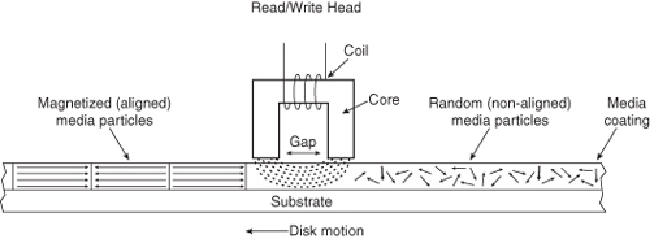Hardware Reference
In-Depth Information
The disk or tape that constitutes the actual storage medium consists of some form of sub-
strate material (such as Mylar for floppy disks, or aluminum or glass for hard disks) on
whichalayerofmagnetizablematerialhasbeendeposited.Thismaterialusuallyisaform
ofironoxidewithvariousotherelementsadded.Eachoftheindividualmagneticparticles
onthestoragemediumhasitsownmagneticfield.Whenthemediumisblank,thepolarit-
ies of those magnetic fields are normally in a state of random disarray. Because the fields
of the individual particles point in random directions, each tiny magnetic field is canceled
out by one that points in the opposite direction; the cumulative effect of this is a surface
with no observable field polarity. With many randomly oriented fields, the net effect is no
observable unified field or polarity.
When a drive's read/write head generates a magnetic field (as when writing to a disk),
the field jumps the gap between the ends of the U shape. Because a magnetic field passes
through a conductor much more easily than through the air, the field bends outward from
the gap in the head and actually uses the adjacent storage medium as the path of least res-
istance to the other side of the gap. As the field passes through the medium directly under
the gap, it polarizes the magnetic particles it passes through so they are aligned with the
field.Thefield'spolarityordirection—and,therefore,thepolarityordirectionofthefield
induced in the magnetic medium—is based on the direction of the flow of electric current
through the coils. A change in the direction of the current flow produces a change in the
direction of the magnetic field. During the development of magnetic storage, the distance
between the read/write head and the media has decreased dramatically. This enables the
gap to be smaller and makes the size of the recorded magnetic domain smaller. The smal-
ler the recorded magnetic domain, the higher the density of data that can be stored on the
drive.
When the magnetic field passes through the medium, the particles in the area below the
head gap are aligned in the same direction as the field emanating from the gap. When the
individual magnetic domains of the particles are in alignment, they no longer cancel one
another out, and an observable magnetic field exists in that region of the medium. This

